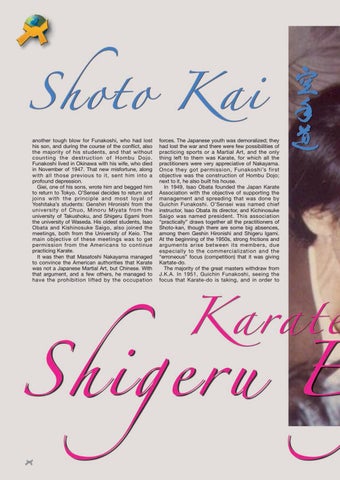another tough blow for Funakoshi, who had lost his son, and during the course of the conflict, also the majority of his students, and that without counting the destruction of Hombu Dojo. Funakoshi lived in Okinawa with his wife, who died in November of 1947. That new misfortune, along with all those previous to it, sent him into a profound depression. Giei, one of his sons, wrote him and begged him to return to Tokyo. O’Sensei decides to return and joins with the principle and most loyal of Yoshitaka’s students: Genshin Hironishi from the university of Chuo, Minoru Miyata from the university of Takushoku, and Shigeru Egami from the university of Waseda. His oldest students, Isao Obata and Kishinosuke Saigo, also joined the meetings, both from the University of Keio. The main objective of these meetings was to get permission from the Americans to continue practicing Karate. It was then that Masatoshi Nakayama managed to convince the American authorities that Karate was not a Japanese Martial Art, but Chinese. With that argument, and a few others, he managed to have the prohibition lifted by the occupation
forces. The Japanese youth was demoralized; they had lost the war and there were few possibilities of practicing sports or a Martial Art, and the only thing left to them was Karate, for which all the practitioners were very appreciative of Nakayama. Once they got permission, Funakoshi’s first objective was the construction of Hombu Dojo; next to it, he also built his house. In 1949, Isao Obata founded the Japan Karate Association with the objective of supporting the management and spreading that was done by Guichin Funakoshi. O’Sensei was named chief instructor, Isao Obata its director, and Kichinosuke Saigo was named president. This association “practically” draws together all the practitioners of Shoto-kan, though there are some big absences, among them Geshin Hironishi and Shigeru Igami. At the beginning of the 1950s, strong frictions and arguments arise between its members, due especially to the commercialization and the “erroneous” focus (competition) that it was giving Kartate-do. The majority of the great masters withdraw from J.K.A. In 1951, Guichin Funakoshi, seeing the focus that Karate-do is taking, and in order to
